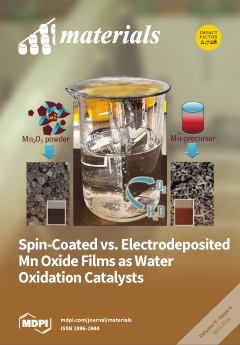Graphitic carbon nitride (
g-C
3N
4) and titanium dioxide (TiO
2) were chosen as a model system to investigate photocatalytic abilities of heterojunction system under UV and visible light conditions. The use of
g-C
3N
4 has been shown to be effective in the reduction in recombination through the interaction between the two interfaces of TiO
2 and
g-C
3N
4. A simple method of preparing
g-C
3N
4 through the pyrolysis of melamine was employed, which was then added to undoped TiO
2 material to form the
g-C
3N
4–TiO
2 system. These materials were then fully characterized by X-ray diffraction (XRD), Brunauer Emmett Teller (BET), and various spectroscopic techniques including Raman, X-ray photoelectron spectroscopy (XPS), Fourier transform infrared spectroscopy (FT-IR), diffuse absorbance, and photoluminescence analysis. Photocatalysis studies were conducted using the model dye, rhodamine 6G utilizing visible and UV light irradiation. Raman spectroscopy confirmed that a composite of the materials was formed as opposed to a mixture of the two. Using XPS analysis, a shift in the nitrogen peak to that indicative of substitutional nitrogen was detected for all doped samples. This is then mirrored in the diffuse absorbance results, which show a clear decrease in band gap values for these samples, showing the effective band gap alteration achieved through this preparation process. When
g-C
3N
4–TiO
2 samples were analyzed under visible light irradiation, no significant improvement was observed compared that of pure TiO
2. However, under UV light irradiation conditions, the photocatalytic ability of the doped samples exhibited an increased reactivity when compared to the undoped TiO
2 (0.130 min
−1), with 4%
g-C
3N
4–TiO
2 (0.187 min
−1), showing a 43.9% increase in reactivity. Further doping to 8%
g-C
3N
4–TiO
2 lead to a decrease in reactivity against rhodamine 6G. BET analysis determined that the surface area of the 4% and 8%
g-C
3N
4–TiO
2 samples were very similar, with values of 29.4 and 28.5 m
2/g, respectively, suggesting that the actual surface area is not a contributing factor. This could be due to an overloading of the system with covering of the active sites resulting in a lower reaction rate. XPS analysis showed that surface hydroxyl radicals and oxygen vacancies are not being formed throughout this preparation. Therefore, it can be suggested that the increased photocatalytic reaction rates are due to successful interfacial interactions with the
g-C
3N
4-doped TiO
2 systems.
Full article






